Restoring Great Lakes Coregonines
Ciscoes & Whitefishes
News Waves
Coregonine Science Webinar Series – upcoming webinar May 3, 2024
Barnaby Roberts (Fisheries Research Station Baden-Württemberg in Langenargen, Germany) will present "What drives phenological variability of Lake...
Fish of the Week: Bringin’ Bloater Back!
Brian Weidel with the USGS Great Lakes Science Center and Dimitry Gorsky from the FWS Great Lakes Fish and Wildlife Conservation Office are guests on the Fish of the Week! podcast.

What are coregonines?
Coregonines are a diverse group of fishes in the salmon family and as many as 11 species once occurred in the Great Lakes. They can be broadly categorized as ciscoes and whitefishes, but are known by many other names (e.g., lake herring, chubs).
A century ago, coregonines were abundant in each lake, occupying diverse habitats- rivers, bays, and the deepest parts of the lakes. Not only were some of the species key prey for top predators like lake trout, but they also supported some of the largest freshwater fisheries ever recorded.
What
happened?
Among the coregonines, the ciscoes declined dramatically between the 1920s and 1970s, due to overfishing, invasive species, and habitat loss. At least two species are now extinct and several species no longer occur in several lakes. The whitefishes have been more resilient, but have been undergoing their own declines in the past 20 years.

What is being done?
Fishery managers have begun prioritizing restoration
In response to changing ecosystems, fishery managers have prioritized the restoration of coregonines given their potential to 1) diversify the prey fish community to better support top predators, 2) improve the efficiency of energy transfer within a lake, and 3) enhance fisheries, given their economic and cultural importance.
Managers endorsed a restoration framework
In 2018, fishery managers across all of the Great Lakes endorsed a science-based, adaptive approach to restore coregonines that can respond to the priorities identified in each lake. The approach includes three primary elements: restoration planning, implementation (e.g., reintroductions, habitat improvements), and evaluation and learning.
Restoration efforts are underway
Bloater reintroduction in Lake Ontario began in 2012, seeking to restore a species that has been extirpated for at least 50 years. Cisco reintroduction into Saginaw Bay, Lake Huron began in 2017; this large embayment was once the most critical habitat for cisco in the entire lake. Additional efforts are currently being considered in other parts of the Great Lakes.
